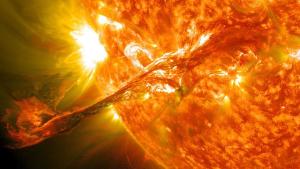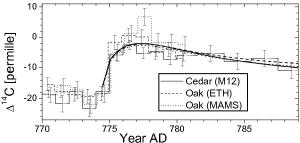Post
Flare Up
16 April 2013
 NASA/SDO/GSFC
NASA/SDO/GSFCBack in January I wrote about a new discovery of a dramatic rise in carbon 14 (C14) in the atmosphere around 774 AD. Carbon 14 is radioactive, and decays over time. It is one of the ways we can date the age of living things long after they’ve died. The reason is because carbon 14 is generated in the atmosphere when high energy particles strike nitrogen atoms in the upper atmosphere, and living thing utilize that carbon while they are alive. Once they die the carbon 14 in them isn’t replenished, so as the carbon 14 decays it over time it gives us a measure of how long an organism has been dead.
Since the level of carbon 14 in the air varies over time, we to account for that historical change when determining the age of objects. Currently we have a calibration table which is accurate to 1% over about 29,000 years. While this is an accurate table, we don’t often have measurements of the levels down to a specific year. But in the article from January, a team was able to measure the C14 levels within the tree rings of two Japanese cedars. Since we know the age of the rings, we can connect the specific C14 levels to a specific year.
What the team found was a 20% increase in C14 around AD 774-775. Since C14 is generated by high-energy particles striking the atmosphere, this would imply either a solar flare or supernova occurred at that time. In the January paper they argued that the rise was too big for a solar flare, and that it was likely due to a supernova. One of the problems with the supernova idea is that it would have needed to be large, and there is no historical evidence of such a supernova at that time. Although as Alun Salt pointed out on Google+, given the difficulty with historical records, that isn’t too unexpected.
This month in Astronomy and Astrophysics a new article1 has been published on the subject. A new team has looked at another set of tree rings. This time from German oak trees. What they found was the same C14 spike as measured in the Japanese cedar trees. This confirms that the spike was a global event, just as we would expect from a supernova or solar flare.
 Usoskin, I. G., et al.
Usoskin, I. G., et al.But in calculating the C14 levels they found the first team had overestimated the rise. This meant it was possible that the spike was caused by a solar flare, and not a supernova. They then looked to historical records of that period looking for reports of aurora borealis (northern lights) at lower latitudes. While northern lights are relatively common at higher latitudes, they are only seen at lower latitudes when there is particular strong solar activity.
The team found reports from China, England, Ireland and Germany from AD 772 - 778 that would seem to be observations of northern lights. It would seem then that this spike was due to solar flares after all.
Usoskin, I. G., et al. “The AD775 cosmic event revisited: the Sun is to blame.” Astronomy & Astrophysics 552 (2013): L3. ↩︎